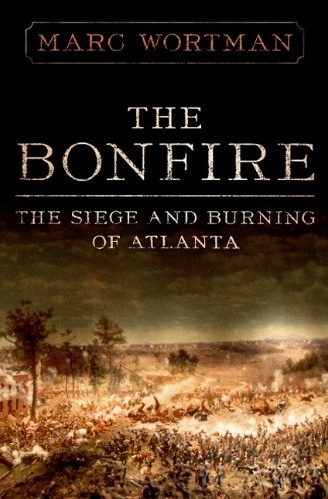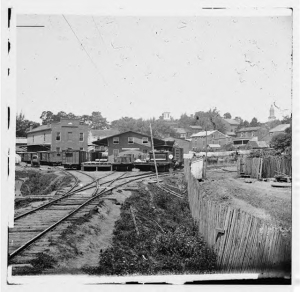Posts Tagged ‘Civil War Railroads’
The Bonfire: The Siege and Burning of Atlanta
The Bonfire: The Siege and Burning of Atlanta
Marc Wortman
ISBN 978-1-58648-482-8
Pub date: 08/11/09
Price: $28.95/36.50 Canada
6 1/8 x 9 1/4
464 pages
The good folks at PublicAffairs Books sent me a review copy of Marc Wortman’s The Bonfire: The Siege and Burning of Atlanta viewable on my virtual bookshelves here. I decided to create a shelf specific to “Civil War Sieges” because this book doesn’t quite fit in other categories. That uniqueness is part of its draw.
Full disclosure: This is my usual “pre-read” post where I’ll share some early impressions. Wortman had me before page one because he put six nicely done maps right up front. His poignant introduction left me with no recourse but to read on. A small excerpt:
War is cruelty. Its bloodshed and destruction – the “hard hand of war,” as Sherman really did call it – struck Atlanta with a greater ferocity than it has any American city in history. This is the story of how Atlanta and its people came to be in the direct line of the whirlwind, what one of the besieged city’s Confederate defenders called “a grand holocaust of death.” (Wortman, 2)
Having read the first chapter, I can say that Wortman has a talent for turning a phrase. His depiction of a devastated Atlanta on the morning of September 2, 1864 put me there.
A reeking sulfurous stew that stung the eyes had already settled over the town, filling the railroad cuts, hollows, and streets. Its tendrils wavered along the hillsides and ravines and sifted through the blackened skeletons of what once were houses and factories, railcars and machine shops. It was the silence, though, that shocked people most. Three predawn hours of gut-rattling, earsplitting, and window-shattering explosions and gunfire made the previous night feel like the announcement that the Apocalypse had finally come. But the infernal noise had ended shortly before morning’s light tipped into the eyes of those hunkered down within the earth. (Wortman, 5)
From reading just a few chapters of book, its TOC, and its index, I can add that Wortman’s work emphasizes the broader historical context of the war, covers the importance of railroads during the Civil War, provides insights into the conflict as seen from the perspectives of common soldiers and citizens, and draws upon a substantial amount of primary sources. All of these are pluses.
I look forward to a thorough reading.
Author Marc Wortman, see his website here, is a freelance journalist of some acclaim. He received his doctorate in Comparative Literature from Princeton University.
An earlier book published by PublicAffairs Books in May of 2007, The Millionaires’ Unit: The Aristocratic Flyboys Who Fought the Great War and Invented American Air Power, also looks like a great read and I recently ordered a copy. Per the publisher, it is in development as a major motion picture. Of note, both of Wortman’s histories are available in Kindle versions which means you can begin reading them in about 40 seconds.
Railroad Generalship: Foundations of Civil War Strategy

I ran across an excellent monograph yesterday by Dr. Christopher R. Gabel titled “Railroad Generalship: Foundations of Civil War Strategy.” It is available in its entirety on the Command and General Staff College’s Combined Arms Research Library here. It includes maps and illustrations.
The following is the foreward by Jerry D. Morelock , Colonel, Field Artillery and Director of the Combat Studies Institute.
“According to an old saying, “amateurs study tactics; professionals study logistics.” any serious student of the military profession will know that logistics constantly shape military affairs and sometimes even dictate strategy and tactics. This excellent monograph by Dr. Christopher Gable shows that the appearance of the steam-powered railroad had enormous implications for military logistics, and thus for strategy, in the American Civil War. Not surprisingly, the side that proved superior in “railroad generalship,” or the utilization of the railroads for military purposes, was also the side that won the war.”
Gabel provides some astonishing statistics which illustrate why railroads challenged traditional strategic direction during the Civil War. He contends that the net effect of “the advent of the steam-powered railroad” was a boost in logistical output by at least a factor of ten. The impact on strategy in the Civil War was staggering. “Most notably, the railroad increased enormously the geographical scale of military operations.” Armies got larger. Sherman’s offensive campaign used 100,000 men and 35,000 animals. His supply line consisted of a single-track railroad extending 473 miles from Atlanta to his main supply base at Louisville. Sherman estimated that this rail line did the work of 36,800 wagons and 220,800 mules!”
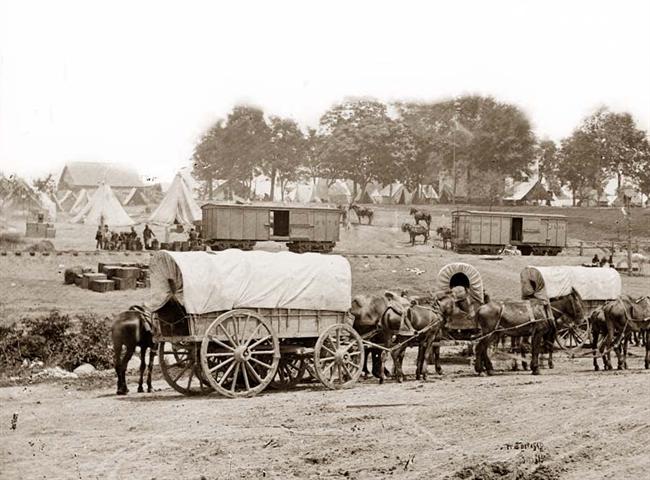
Civil War Wagons
For those of you really into military strategy, Gabel provides a simple yet effective illustration of “interior lines” and “exterior lines” and why railroads sometimes helped and other times hindered Civil War strategists who tried to use Jomini/Napoleonic concentration on “interior lines” strategy.
Regular followers of Wig Wags will know that I’ve posted on this fascinating topic before. See the page, Civil War Railroads here.
Highly recommend.
Christopher R. Gabel, “Railroad Generalship: Foundations of Civil War Strategy.” http://www-cgsc.army.mil/carl/resources/csi/gabel4/gabel4.asp#org, Accessed: May 24, 2009.
Free or Inexpensive American Civil War Titles for Kindle

I’ve spent some time at the Kindle Store perusing their books for deals on American Civil War Books. I’ll follow up with additional lists on Military History and History in general although they are numerous. One plus – many of the Army Field manuals are available for $0.99, You could, of course, download most of the latter from other sites and load to you Kindle as well.
Of note, David Woodbury over at of Battlefields and Bibliophiles has posted an outstanding piece on the digitalization of books phenomena which you can read here.
Here’s my list so far of ACW books that are free or under $2.00 in the Kindle Store. Bear in mind that most of these are in the public domain so you can also load them to your Kindle 2 for free in the manners I described in previous posts.
General Histories
History of the Civil War, 1861 – 1865 by James Ford Rhodes $0.99
Memoirs and Biographies
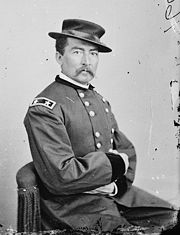
Sheridan
Personal Memoirs of P. H. Sheridan, General, United States Army Volume 1 by Philip Henry, General, 1831-1888 Sheridan – $0.00
Personal Memoirs of P. H. Sheridan, General, United States Army Volume 2 by Philip Henry, General, 1831-1888 Sheridan – $0.00
Personal Memoirs of P.H. Sheridan, both volumes in one file by Philip Henry Sheridan – $0.99
Personal Memoirs of U. S. Grant Volume 1 by Ulysses S. (Ulysses Simpson), 1822-1885 Grant – $0.00
Personal Memoirs of U. S. Grant Volume 2 by Ulysses S. (Ulysses Simpson), 1822-1885 Grant – $0.00
Personal Memoirs of Ulysses S. Grant by Ulysses S. Grant and Mark Twain- $0.99
Letters of Ulysses S. Grant to His Father and His Youngest Sister, 1857-1878 by Ulysses S. Grant and Jesse Grant Cramer – $0.99
Campaigning with Grant (1907, [c1897]), First Person Account of Ulysses S. Grant During the Civil War by Horace Porter – $1.59

Stonewall Jackson
Stonewall Jackson and the American Civil War, both volumes in a single file by Colonel G.F.R. Henderson – $0.99
Stonewall Jackson and the American Civil War by G. F. R. Henderson – $0.99
Stonewall Jackson and the American Civil War by G.F.R. Henderson and Viscount Wolseley – $0.99

Lee
The Life of General Robert E. Lee by Captain Robert E. Lee (his son) – $0.99
A Life of General Robert E. Lee by John Esten Cooke – $0.99
Recollections and Letters of General Robert E. Lee by his son by Captain Robert E. Lee – $0.99
With Lee in Virginia, a Story of the American Civil War by G.A. Henty – $0.99

W. T. Sherman
Memoirs of General William T. Sherman by William T. Sherman – $0.99
Thirteen Months in the Rebel Army by William G. Stevenson – $0.99
Captains of the Civil War – A Chronicle of the Blue and the Gray by William Wood – $0.99
Military Reminiscences of the Civil War, both volumes in a single file by Jacob Dolson Cox – $0.99
Military Reminiscences of the Civil War, Volume 1 by Jacob Dolson Cox – $1.84
Military Reminiscences of the Civil War, Volume 2 by Jacob Dolson Cox – $1.84
Reminiscences of Two Years with the Colored Troops by Joshua M. Addeman – $0.99
Army Life in a Black Regiment by Thomas Wentworth Higginson – $1.00
Heroes of the Great Conflict: Life and Services of William Farrar Smith, Major General, United States Volunteer in the Civil War by James Harrison Wilson – $0.99
The Scouts of Stonewall: The Story of the Great Valley Campaign by Joseph A. (Joseph Alexander), 1862-1919 Altsheler
The Rise and Fall of the Confederate Government by Jefferson Davis
Regimental Histories
History of Company E of the Sixth Minnesota Regiment by Alfred J. Hill – $1.59
Women
Woman’s Work in the Civil War; A Record of Heroism, Patriotism, and Patience by M.D. L. P. Brockett – $1.80
Memories: a Record of Personal Experience and Adventure During Four Years of War by Mrs. Fannie A. Beers – $0.99
Fortifications and Armaments
A History of Lumsden’s Battery, C.S.A. by Dr. George Little and james R. Maxwell – $1.99
History of the Confederate Powder Works by George W. Rains- $1.19
Naval
![the-fight-between-the-alabama-and-the-kearsarge-nh59354 "The Fight Between the Alabama and the Kearsarge" [NH59354]](https://wigwags.files.wordpress.com/2008/09/the-fight-between-the-alabama-and-the-kearsarge-nh59354.jpg?w=700)
The Story of the Kearsarge and the Alabama by A. K. Browne – $0.99
The Cruise of the Alabama and the Sumter, both volumes in a single file by Raphael Semmes- $0.99
Railroads
The Great Railroad Adventure – a True Tale from the American Civil War by Lieut. William Pittenger – $0.99
Prisons
Andersonville: a Story of Rebel Military Prisons, all four volumes in a single file by John McElroy – $0.99
Other Biography

John Wilkes Booth
The Life, Crime & Capture of John Wilkes Booth by George Alfred Townsend – $0.99
Speeches and Legislative Documents
Abraham Lincoln’s Second Inaugural Address by Abraham Lincoln – $0.49
Lincoln’s Gettysburg Address by Abraham Lincoln – $0.49
The Emancipation Proclamation (Preliminary and Final Version) by Abraham Lincoln and William Seward – $0.80
Jefferson Davis’ Inaugural Address by Jefferson Davis – $0.99
Civil War Photography
Taking Photographs During the Civil War – $0.80
Fiction
The Little Regiment and Other Episodes of the American Civil War by Stephen Crane. Published by MobileReference (mobi) by Stephen Crane – $0.99
The Red Badge of Courage by Stephen Crane – $0.99
Nightly News video : Railroads woven into presidential history
NBC Nightly News ran this piece tonight. My buddy Peter Hansen (above) is interviewed toward the end. His clip was filmed here in Kansas City behind the headquarters of Kansas City Southern Railway next to what is known as the Harry Truman Car. That would make his second national news program in a week or so. Not bad! See his contributions in my popular series titled Civil War Railroads here.
If the video below doesn’t play, click here or on Pete’s image above.
Vodpod videos no longer available.
Civil War Railroad Page Updated
By way of housekeeping, I’ve updated the Popular Series Posts page on the right nav bar titled Civil War Railroads here with the latest series of posts titled “Stewards of Civil War Railroads.”

Above: United States Military Railroad 4-4-0 locomotive W.H. Whiton (built by William Mason in 1862) in January 1865 with Abraham Lincoln’s presidential car, which later was used as his funeral car.
Source: Wikicommons
Stewards of Civil War Railroads – Part III
This post completes the series, Stewards of Civil War Railroads. Read Part I here and Part II here.

Above: Group of the Construction Corps U.S. Mil. R. Rds., with working tools, etc., Chattanooga, Tennessee
Courtesy of Library of Congress: LC-USZ62-62364
Millett and Maslowski posit that President Abraham Lincoln did not have Jefferson Davis’ sensitivity about government interference with railroads. The evidence supports the point and also suggests that Davis’ hands-off approach expanded to other areas under his purview including signals and communications. Whether he was afflicted with chronic indecisiveness or was bowing to the perceived whims of a public unreceptive to “big government” is open for discussion but as in many things, the truth probably lies somewhere in between. Regardless, it is clear that rational military considerations were not the sole concern in shaping the South’s military policies and programs. Had they been so, military needs would have received higher priority and the events of the war may have flowed differently.
Above: Lincoln and McClellan
The impact of the decision making processes in the Lincoln and Davis administrations and the respective Congresses as regards those issues impacting the military is indeed a fascinating one and worthy of continued analysis and review. Clearly the social, economic, and political nuances of the North versus the South had much to do with the directions taken within each section. But one is left to wonder whether the leadership qualities of Lincoln and Davis, including the ability to be decisive, allowed the North to more frequently follow a path guided by rational military reason.
Above: The engine “Firefly” on a trestle of the Orange and Alexandria Railroad.
Stewards of Civil War Railroads – Part II Davis
This post continues from Part I, here.
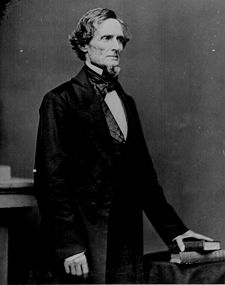
Jefferson Davis (above) and the Confederate Congress, by contrast, were reluctant to wrestle control of the railroads away from civilian owners. This was consistent with a laissez faire pattern exhibited by Davis on a number of issues involving civilian commercial interests and may have been a response to the populace’s opposition to overbearing centralized government. The consequences were dire for Lee. In the winter of 1862, he found his Army of Northern Virginia completely reliant on its communications. [i]
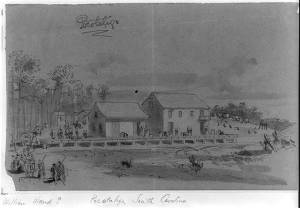
Above: Pocotaligo, South Carolina – Railroad depot center of image surrounded by rough sketch of soldiers and covered wagons. Circa: 1865
Medium: 1 drawing on tan paper : pencil, black ink wash, and Chinese white ; 14.7 x 21.4 cm. (sheet).
Source: Library of Congress Ref: LC-USZ62-14306 (b&w film copy neg.)
With the mobility, indeed the survival, of the army dependent on the efficient use of the railroads, the railroad owners responded with an assertion of their individual rights. They failed to cooperate. Government shipments were accorded low priority. The railroads over which the animals’ feed had to be transported refused to use the space for bulk fodder. The breakdown of the railroad system led to a crisis in the supply of horses, mules, fodder, and subsistence. The Army of Northern Virginia was left hanging at the end of its lines of communications.[ii]
Above: Warrenton Depot, on the Orange & Alexandria RR, in August 1862. Supply point for Lee.
Davis’ refusal to give greater control to the military for operation of the railroads added to “the weight of this burden of waging war by improvisation within the confines of the Confederacy’s social and political ideals [and] helped break the back of Confederate offensive power.” [iii]
Edward Hagerman notes that problems continued into 1863 as “conflicts between the commissary agents of field commanders and those of the [Confederate] Subsistence Department hampered efficient gathering of available resources.” [iv] The largest obstacle was “the failure of the railroads to cooperate in the distribution of food surpluses from other states to the Army of Northern Virginia. Neither the army nor the government exercised any control over the railroads.” [v] It wasn’t until Lee’s army was faced with starvation that the Confederate Congress intervened. In April of 1863, it “hesitantly” granted Jefferson Davis the “authority to regulate the railroads.” [vi]
The laissez faire-minded Davis was as reluctant to accept the authority as the Confederate Congress was to bestow it. Here was the instrument to prevent a recurrence of the crisis of the past winter. It would enable through scheduling the interchange of rolling stock from one railroad to another. It also would enable the War Department, rather than the railroad owners, to decide on the priority of material to be transported. [vii]
Davis signed the bill into law but Congress ensured its ineffectiveness by failing to approve an “office of railroad superintendent” as proposed by the secretary of war and by sacking the temporary appointee. [viii] “Not until early 1865, far too late, did the Confederacy finally take control of the railroads.” [ix]
[i, ii, iii] Edward Hagerman, The American Civil War and the Origins of Modern Warfare: Ideas, Organization, and Field Command (Bloomington: Indiana University Press, 1988), 121.
[iv, v] Ibid., 130.
[vi, vii, viii] Ibid., 131.
[ix] Allan R. Millett and Peter Maslowski, For the Common Defense: A Military History of the United States of America, 165.
